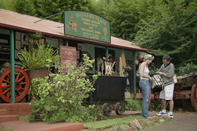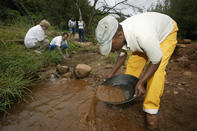Sense of the Past
Pilgrim’s Rest has a beautifully restored Royal Hotel. There’s fine Victorian furniture, brass bedsteads, ball-and-claw baths and a lovely pub (originally the chapel of St Cyprians Girls School in Cape Town, dismantled and shipped to Maputo, then transported by ox wagon to Pilgrim’s Rest).

Wandering beneath jacaranda boughs through the timber-and-corrugated-iron town you get a palpable sense of its gold-rush past. Within a year of the discovery of gold, 1873, there were 1 500 diggers jostling the banks of Pilgrim’s Creek panning for alluvial fortunes.
Sprinkling of Gold Dust
Justice was rough and if you were banished from the town for a transgression such as theft or working someone else’s claim, it was best to stay away. The robber’s grave in the local cemetery attests to one unfortunate who was shot on his return. A plaque on Robber’s Pass also notes the last coach robbery in the region (1912). The highwayman foolishly headed straight to town to pay his debts and was caught at the Royal Hotel ‘church’ (pub).
Pilgrim’s Rest has a Diggings Site Museum, which gives visitors a sense of life on the claims. Beneath a fluttering Union Jack are diggers’ tents, the doctor’s shack, a tented bar and the gold commissioner’s office. A staff member can take you through the mining process, and even do some panning for visitors. He digs soil from the brook and swirls the muddy mess in his pan until only a sprinkling of gold dust remains.
By Justin Fox

